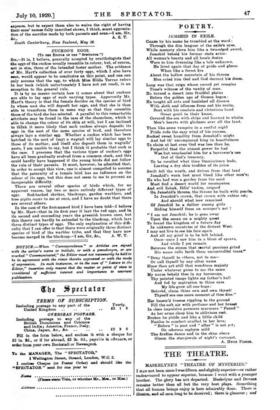CUCKOO'S EGGS.
(To THE EDITOR Or THE " SPECTATOE."3 SHE,--It is, I believe, generally accepted by ornithologists that the eggs of the cuckoo usually resemble in colour, but, of course, not in size, those of the intended foster mother. The evidence of Mr. Hart's collection of over forty eggs, which I also have seen, would appear to be conclusive on this point, and one can only assume that the egg, 4o which Miss Hilda Torras refers in her book (which unfortunately I have not yet read), is an exception to the general rule.
It is by no means certain how it comes about that cuckoos are able to lay eggs of such varying types. Apparently Mr. Hart's theory is that the female decides on the species of bird In whose nest she will deposit her eggs, and that she is then able to transform them in some way so that they resemble tholes of the bird she has selected. A parallel to this remarkable attribute may be found in the case of the chameleon, which is able to change the colour of its skin at will, but I am inclined to think it more likely that each cuckoo always deposits its eggs in the nest of the same species of bird, and therefore always lays a similar egg. Whether a cuckoo which has been hatched in the nest of (say) a wagtail will lay similar eggs to those of its mother, and itself also deposit them in wagtails' nests, I am unable to say, but I think it probable that such is the case. I presume that the various types of cuckoo's eggs have all been gradually evolved from a common stock, and this could hardly have happened if the young birds did not follow the rule of their parents. It must, however, be admitted that, In order to accept this view, one is almost compelled to assume that the paternity of a female bird has no influence on the colour of its eggs, but this does not seem to me to present an insuperable difficulty.
There are several other species of birds which, for no apparent reason, lay two or more entirely different types of eggs. Red-backed shrikes, blackcaps, garden warblers, and tree pipits occur to me at once, and I have no doubt that there are several others.
In the case of the first-named bird I have been told—I believe by Mr. Hart—that in its first year it lays the red eggs, and in its second and succeeding years the greenish brown ones, but this theory can hardly be extended to 4he blackcap, which lays three distinct types of eggs. The only explanation of this diffi- culty that I can offer is that there were originally three distinct species of bird of the warbler tribe, and that they have now
become merged in the blackcap.—I am, Sir, ese., A. W. T.


































 Previous page
Previous page